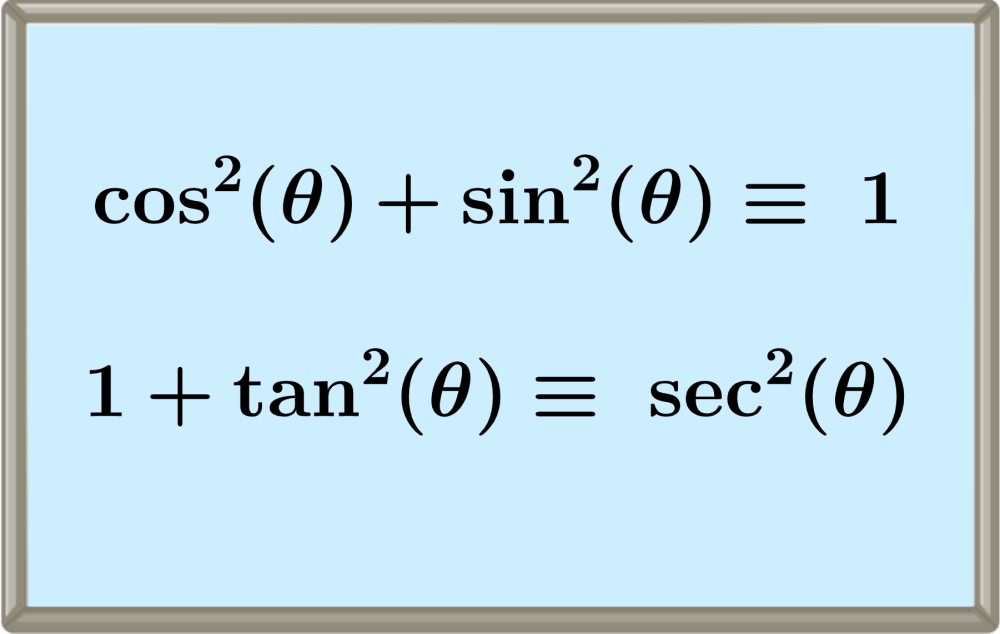The trigonometric identities can be proved by using other, simpler trigonometric identities. Then, we can use the simple identities to manipulate the original trigonometric identities until both sides are equal or equivalent to 0 or 1.
Here, we will learn about the general process for proving trigonometric identities. Then, we’ll apply what we’ve learned to solve some practice problems.
How to prove trigonometric identities?
To prove a trigonometric identity, we have to show that the identity is true for all values of the angle.
For example, consider the following identity:
$$\tan(\theta)+\cot(\theta)\equiv \sec(\theta)\cosec(\theta)$$
We could substitute values of θ on both sides of the identity, and this would show that the identity is true for those particular values of θ.
However, this does not prove that the identity is true for all values of θ.
The trigonometric identities can be proved by using other simpler identities that we know to be true for all values of θ.
For example, we know that the following identities are true for all values of θ:
- $latex \tan(\theta)\equiv \dfrac{\sin(\theta)}{\cos(\theta)}$
- $latex \sin^2(\theta)+\cos^2(\theta)\equiv 1$
- $latex 1+\tan^2(\theta)\equiv \sec^2(\theta)$
- $latex 1+\cot^2(\theta)\equiv \cosec^2(\theta)$
Then, we can choose either the left-hand side (LHS) or the right-hand side (RHS) of the identity and manipulate them using simple identities until we get the expression of the other side.
Alternatively, it is also possible to prove that the identity is true by showing that:
- $latex \text{LHS} -\text{RHS}\equiv 0~~$ or
- $latex \frac{\text{LHS}}{\text{RHS}}\equiv 1$
Proving trigonometric identities – Examples with answers
EXAMPLE 1
Prove that the following identity is true:
$$\tan (\theta)+\cot(\theta)\equiv \sec(\theta)\cosec(\theta)$$
Solution
We are going to take the left-hand side and use simple identities until we get the expression for the right-hand side:
$$\text{LHS} \equiv \tan(\theta)+\cot(\theta)$$
$$ \equiv \frac{\sin(\theta)}{\cos(\theta)}+\frac{\cos(\theta)}{\sin(\theta)}$$
$$ \equiv \frac{\sin^2(\theta)+\cos^2(\theta)}{\sin(\theta) \cos(\theta)}$$
Now, we can use the identity $latex \sin^2(\theta)+\cos^2(\theta)\equiv 1$:
$$\text{LHS} \equiv \frac{1}{\sin(\theta) \cos(\theta)}$$
$$ \equiv \frac{1}{\sin(\theta) }\times \frac{1}{ \cos(\theta)}$$
$$ \equiv \cosec(\theta) \sec(\theta)\equiv RHS$$
We have shown that the identity is true.
EXAMPLE 2
Prove the following trigonometric identity:
$$\sin(\theta)\tan(\theta)+ \cos(\theta)\equiv \sec(\theta)$$
Solution
We are going to manipulate the left-hand side using simple trigonometric identities:
$$\text{LHS} \equiv \sin(\theta)\tan(\theta)+ \cos(\theta)$$
$$ \equiv \sin(\theta) \frac{\sin(\theta)}{\cos(\theta)}+\cos(\theta)$$
$$ \equiv \frac{\sin^2(\theta)}{\cos(\theta)}+ \cos(\theta)$$
Now, we multiply the numerator and denominator of $latex \cos(\theta)$ by $latex \cos(\theta)$:
$$ \text{LHS} \equiv \frac{\sin^2(\theta)}{\cos(\theta)}+ \frac{\cos^2(\theta)}{\cos(\theta)}$$
$$ \equiv \frac{\sin^2(\theta)+\cos^2(\theta)}{\cos(\theta)}$$
Using the identity $latex \sin^2(\theta)+\cos^2(\theta)\equiv 1$, we have:
$$\text{LHS} \equiv \frac{1}{\cos(\theta)}$$
$$ \equiv \sec(\theta)\equiv RHS$$
The left-hand side is equal to the right-hand side. This means that the identity is true.
EXAMPLE 3
Prove the following trigonometric identity:
$$\cosec(\theta)+\tan(\theta)\sec(\theta)\equiv \cosec(\theta) \sec^2(\theta)$$
Solution
Taking the left-hand side, we can manipulate as follows:
$$\text{LHS} \equiv \cosec(\theta)+\tan(\theta)\sec(\theta)$$
$$ \equiv \frac{1}{\sin(\theta)}+\frac{\sin(\theta)}{\cos(\theta)} \times \frac{1}{\cos(\theta)}$$
$$ \equiv \frac{1}{\sin(\theta)}+\frac{\sin(\theta)}{\cos^2(\theta)}$$
$$ \equiv \frac{\cos^2(\theta)+\sin^2(\theta)}{\sin(\theta)\cos^2(\theta)}$$
Using the identity $latex \sin^2(\theta)+\cos^2(\theta)\equiv 1$, we have:
$$\text{LHS} \equiv \frac{1}{\sin(\theta)\cos^2(\theta)}$$
$$ \equiv \frac{1}{\sin(\theta) }\times \frac{1}{ \cos^2(\theta)}$$
$$ \equiv \cosec(\theta) \sec^2(\theta)\equiv RHS$$
Since both sides are equal, the identity is true.
EXAMPLE 4
Use simple identities to prove the following trigonometric identity:
$$(\sin(\theta)+\cos(\theta))^2-1\equiv 2 \sin(\theta)\cos(\theta)$$
Solution
Let’s take the left-hand side of the identity and let’s expand the quadratic binomial:
$$\text{LHS} \equiv (\sin(\theta)+\cos(\theta))^2-1$$
$$ \equiv \sin^2(\theta)+2\sin(\theta)\cos(\theta)+\cos^2(\theta)-1$$
$$ \equiv 2\sin(\theta)\cos(\theta)+(\sin^2(\theta)+\cos^2(\theta))-1$$
Using the identity $latex \sin^2(\theta)+\cos^2(\theta)\equiv 1$, we have:
$$\text{LHS} \equiv 2\sin(\theta)\cos(\theta)+1-1$$
$$ \equiv 2\sin(\theta)\cos(\theta)$$
The left-hand side is equal to the right-hand side, so the identity is true.
EXAMPLE 5
Prove the following trigonometric identity:
$$(\sin(\theta)-\cosec(\theta))^2\equiv \sin^2(\theta)+\cot^2(\theta)-1$$
Solution
Taking the left-hand side and expanding the square binomial, we have:
$$\text{LHS} \equiv (\sin(\theta)-\cosec(\theta))^2$$
$$ \equiv \sin^2(\theta)-2\sin(\theta)\cosec(\theta)+\cosec^2(\theta)$$
$$ \equiv \sin^2(\theta)-2\sin(\theta)\frac{1}{\sin(\theta)}+\cosec^2(\theta)$$
$$ \equiv \sin^2(\theta)-2+\cosec^2(\theta)$$
Now, we can use the identity $latex \cosec^2(\theta)\equiv \cot^2(\theta)+ 1$:
$$\text{LHS} \equiv \sin^2(\theta)-2+\cot^2(\theta)+ 1$$
$$ \equiv \sin^2(\theta)+\cot^2(\theta)- 1$$
Since the left-hand side could be written as the right-hand side, the identity is true.
EXAMPLE 6
Use simple identities to prove the following trigonometric identity:
$$ \frac{\cosec(\theta)}{\cot(\theta)+\tan(\theta)} \equiv \cos(\theta)$$
Solution
Let’s manipulate the left-hand side with simple identities:
$$\text{LHS} \equiv \frac{\cosec(\theta)}{\cot(\theta)+\tan(\theta)}$$
$$ \equiv \frac{\cosec(\theta)}{\frac{\cos(\theta)}{\sin(\theta)}+\frac{\sin(\theta)}{\cos(\theta)}}$$
$$ \equiv \frac{\cosec(\theta)}{\frac{\cos^2(\theta)+\sin^2(\theta)}{\sin(\theta)\cos(\theta)}}$$
Using the identity $latex \sin^2(\theta)+\cos^2(\theta)\equiv 1$, we have:
$$\text{LHS} \frac{\cosec(\theta)}{\frac{1}{\sin(\theta)\cos(\theta)}}$$
$$ \equiv \cosec(\theta) \sin(\theta)\cos(\theta)$$
$$ \equiv \frac{1}{\sin(\theta)} \sin(\theta)\cos(\theta)$$
$$ \equiv \cos(\theta) \equiv RHS$$
We have shown that the identity is true.
EXAMPLE 7
Prove the following trigonometric identity:
$$ \frac{1}{1+\tan^2(\theta)}+\frac{1}{1+\cot^2(\theta)} \equiv 1$$
Solution
Taking the left-hand side, we have:
$$\text{LHS} \equiv \frac{1}{1+\tan^2(\theta)}+\frac{1}{1+\cot^2(\theta)}$$
Now, we are going to use the identities $latex 1+\tan^2(\theta)\equiv \sec^2(\theta)$ and $latex 1+\cot^2(\theta)\equiv \cosec^2(\theta)$:
$$\text{LHS} \equiv \frac{1}{1+\sec^2(\theta)-1}+\frac{1}{1+\cosec^2(\theta)-1}$$
$$\equiv \frac{1}{\sec^2(\theta)}+\frac{1}{\cosec^2(\theta)}$$
$$\equiv \cos^2(\theta)+\sin^2(\theta)$$
Using the identity $latex \sin^2(\theta)+\cos^2(\theta)\equiv 1$, we have:
$$\text{LHS} \equiv 1 \equiv RHS$$
Since both sides are equal, the identity is true.
EXAMPLE 8
Use simple identities to prove that the following identity is true:
$$ (1-\sin(\theta)+\cos(\theta))^2\equiv 2(1-\sin(\theta))(1+\cos(\theta)) $$
Solution
Taking the left-hand side, we can expand the square binomial:
$$\text{LHS} \equiv (1-\sin(\theta)+\cos(\theta))^2$$
$$ \equiv (1-\sin(\theta)+\cos(\theta))(1-\sin(\theta)+\cos(\theta))$$
$$ \equiv 1-2\sin(\theta)+2\cos(\theta)+\sin^2(\theta)+\cos^2(\theta)-2\sin(\theta)\cos(\theta)$$
Using the identity $latex \sin^2(\theta)+\cos^2(\theta)\equiv 1$, we have:
$$ \text{LHS} \equiv 2-2\sin(\theta)+2\cos(\theta)-2\sin(\theta)\cos(\theta)$$
$$ \equiv 2(1-\sin(\theta)+\cos(\theta)-\sin(\theta)\cos(\theta))$$
$$ \equiv 2(1-\sin(\theta))(1+\cos(\theta)) \equiv RHS$$
We have proved the identity.
EXAMPLE 9
Prove the following trigonometric identity:
$$\frac{1+\sin(\theta)}{1-\sin(\theta)} \equiv (\tan(\theta)+\sec(\theta))^2$$
Solution
Taking the right-hand side of the identity, we have:
$$\text{RHS} \equiv (\tan(\theta)+\sec(\theta))^2$$
$$ \equiv \left(\frac{\sin(\theta)}{\cos(\theta)}+\frac{1}{\cos(\theta)}\right)^2$$
$$ \equiv \left(\frac{\sin(\theta)+1}{\cos(\theta)}\right)^2$$
$$ \equiv \frac{(1+\sin(\theta))^2}{\cos^2(\theta)}$$
Now, we use the identity $latex \sin^2(\theta)+\cos^2(\theta)\equiv 1$:
$$\text{RHS} \equiv \frac{(1+\sin(\theta))^2}{1-\sin^2(\theta)}$$
$$ \equiv \frac{(1+\sin(\theta))^2}{(1+\sin(\theta))(1-\sin(\theta))}$$
$$ \equiv \frac{1+\sin(\theta)}{1-\sin(\theta)}\equiv LHS$$
Since both sides are equal, the identity is true.
EXAMPLE 10
Prove that the following identity is true:
$$ \sqrt{\sec^2(\theta)-1}+\sqrt{\cosec^2(\theta)-1}\equiv \frac{1}{\sin(\theta)\cos(\theta)}$$
Solution
We can simplify the LHS by using the identities $latex 1+\tan^2(\theta)\equiv \sec^2(\theta)$ and $latex 1+\cot^2(\theta)\equiv \cosec^2(\theta)$:
$$\text{LHS} \equiv \sqrt{\sec^2(\theta)-1}+\sqrt{\cosec^2(\theta)-1}$$
$$ \equiv \sqrt{\tan^2(\theta)+1-1}+\sqrt{\cot^2(\theta)+1-1}$$
$$ \equiv \sqrt{\tan^2(\theta)}+\sqrt{\cot^2(\theta)}$$
$$ \equiv \tan(\theta)+ \cot(\theta)$$
$$ \equiv \frac{\sin(\theta)}{\cos(\theta)}+ \frac{\cos(\theta)}{\sin(\theta)}$$
$$ \equiv \frac{\sin^2(\theta)+\cos^2(\theta)}{\cos(\theta)\sin(\theta)}$$
Using the identity $latex \sin^2(\theta)+\cos^2(\theta)\equiv 1$, we have:
$$\text{LHS} \equiv \frac{1}{\sin(\theta) \cos(\theta)} \equiv RHS$$
We have shown that the identity is true.
See also
Interested in learning more about trigonometric identities? You can take a look at these pages:




